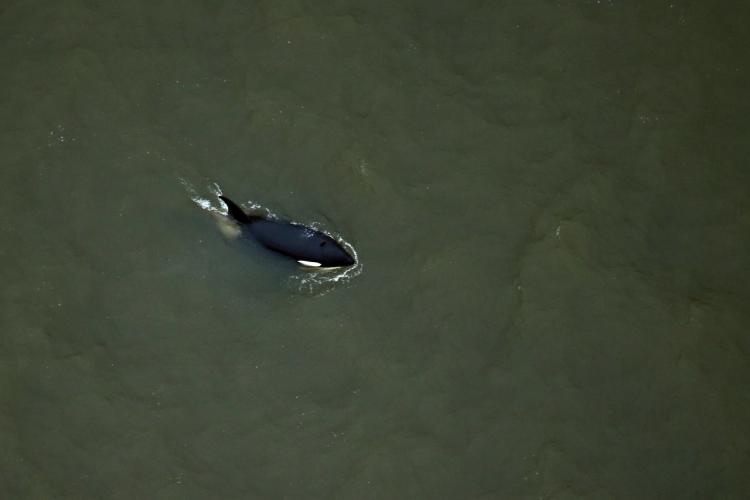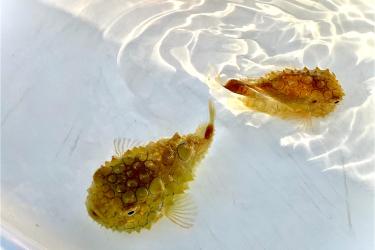
Killer whale adult and calf sighted approximately 30 miles west of Stuart Island in Norton Sound, Alaska, 29 June 2017.
Our time in Norton Sound sure flew by! We wrapped up our survey of the Eastern Bering Sea stock of beluga whales on June 29th with an impressive amount of survey effort. We flew 16 flights in the 14-day period. Even though we had two ‘down days’ due to weather, we had 4 days when we flew two survey flights, averaging eight to nine hours of flying each of those days! We flew 66 hours in the study area and logged 9600 miles.
Most importantly, we were able to survey what is considered the prime habitat for Eastern Bering Sea belugas around the Yukon River Delta three times in two weeks. We also covered the majority of the tracklines over the rest of Norton Sound twice. That is a lot of flying!
The belugas were concentrated around the Yukon River Delta, and north of Pastol Bay and Stuart Island out to the middle of Norton Sound. This distribution is similar to surveys in 1992-2000, except the region offshore and north of Unalakleet had much higher densities of beluga sightings in our current study.
On our last survey day, although weather conditions were excellent, we had only a few beluga sightings. However, we were surprised and pleased with an unusual sighting of six killer whales approximately 30 miles west of Stuart Island, off the Yukon River Delta. We are hopeful the aerial photos of the killer whales will give us some insight into whether they are fish- or marine mammal-eaters. The turbid waters of the delta made it difficult to obtain photos that can be used for photo identification, but we took our best shots.
Now that we’ve packed up and returned home, our project leadership will start the process of reviewing and analyzing the data we collected over the past two weeks to estimate the population abundance of the Eastern Bering Sea beluga stock.

Gray whale cow and calf sighted approximately 80 miles west of Stuart Island in Norton Sound, Alaska, 29 June 2017.

Norton Sound Beluga Survey cumulative survey effort and beluga sightings, 16-29 June 2017. Beluga sighting symbols are scaled by group size.
Meet the Bloggers

Ameilia Brower
Amelia Brower is a NOAA Fisheries affiliate with the NOAA Fisheries' Alaska Fisheries Science Center through the Joint Institute for the Study of the Atmosphere and Ocean at the University of Washington (UW). Amelia began working with marine mammals in 2006. She has participated in marine mammal necropsies, seal, sea lion, and fur sea lion rehabilitation and diet and life history studies, bone preservation, monitoring for manatees and other marine life from dredges, oceanographic sampling, small boat surveys for toothed whales off Hawaii, and seal, sea lion, and North Atlantic right whale aerial surveys. Amelia Brower joined the Aerial Surveys of Arctic Marine Mammals (ASAMM) project in 2009 as a seasonal observer and as a year-round core team member in 2010. Amelia is a team leader during the field season and spends the rest of the year error-checking and analyzing data and photos and assisting with and producing reports, presentations, and scientific publications. Amelia’s work within the ASAMM data has focused on gray whale feeding in the northeastern Chukchi Sea and humpback, fin, and minke whale distribution in the Chukchi Sea. She also serves as the ASAMM polar bear data liaison.

Christy Sims
Christy Sims is a NOAA Fisheries affiliate through the Joint Institute for the Study of the Atmosphere and Ocean at the University of Washington (UW). Christy started as a photo-identification volunteer at the Alaska Fisheries Science Center in 1998, and has been working with the Cook Inlet beluga whale project since completing her Masters of Marine Affairs at the UW in 2001. Christy has worked as observer and videographer on the Cook Inlet beluga aerial surveys since 2003 as well as working on photo-id projects on humpback and bowhead whales. She has also participated in Aerial Survey of Alaska Marine Mammals (ASAMM) as a team leader since 2012. When she isn't flying around Alaska in a small plane, Christy is in Seattle analyzing data or designing and managing databases.

Amy Willoughby
Amy Willoughby is a marine mammal biologist at NOAA Fisheries’ Alaska Fisheries Science Center. Amy began her career on the sandy beaches of Florida’s Atlantic coast where she conducted sea turtle nesting surveys. She took to the skies in 2009 as an aerial survey observer for the Florida Fish and Wildlife Conservation Commission’s North Atlantic right whale Early Warning System project. Since then she has logged hundreds of flight hours searching for protected marine species in the Gulf of Mexico and coastal waters from New Jersey to South Carolina. Amy has been involved in numerous field projects, conducting research on a range of species including salmon, marbled murrelets, bottlenose dolphins, ice-associated seals, and polar bears. In 2014, Amy headed to the Alaska Arctic for a seasonal position with the Aerial Surveys of Arctic Marine Mammals (ASAMM) project as a marine mammal observer and was fortunate to have the project invite her on as a full-time employee. Since then, she has worked for ASAMM year-round on fieldwork logistics, data management and analysis, and reports, and she serves as team leader and walrus data liaison during field operations.


